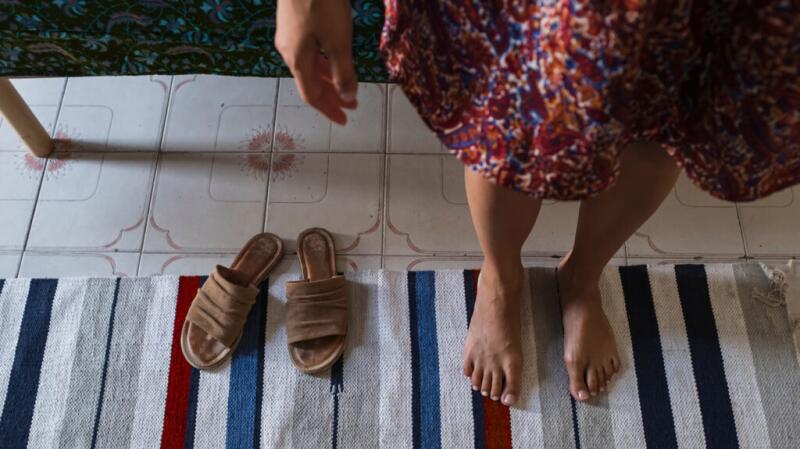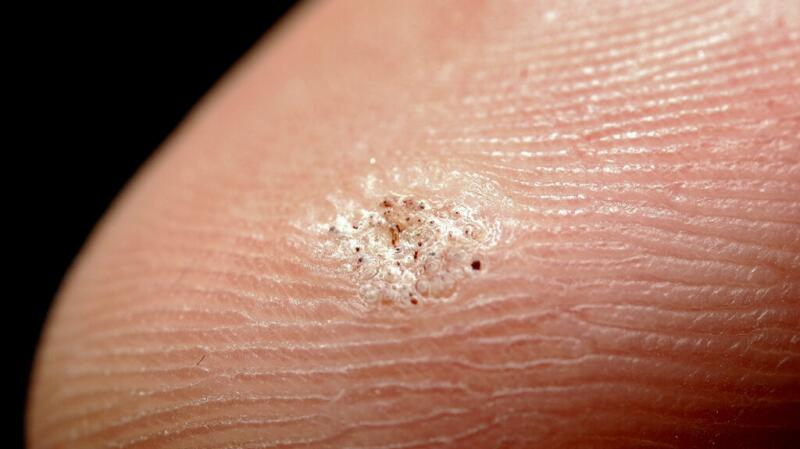Warts affect about 10% of the world’s population and are more common in children and white people.
Seed warts can easily spread by skin-to-skin contact or from contaminated surfaces or objects. While they can cause discomfort, seed warts are harmless and may resolve on their own without treatment.
This article will discuss the causes and treatments of seed warts, including home remedies and clinical care. It will also discuss what you can do to help prevent them.

A seed wart is a type of common wart. They are called “seed” warts due to the black dots resembling seeds that appear in the tissue of the wart.
Seed warts usually appear on your hands in areas around the nails or on the backs of the hands. However, they can occur elsewhere. They may feel like rough or hard bumps and can be flesh colored, although can vary in appearance.
You may have a single wart or clusters of warts.
Seed warts vs. plantar warts
Some plantar warts may also have black dots. This makes both seed and plantar warts easy to distinguish from other calluses and tissue growths. However, there are several differences between common warts and plantar warts.
Differences between a seed wart and a plantar wart include:
- Location: Plantar warts most often develop on the sole or bottom of the feet, and can grow deep into the skin. Seed warts commonly appear elsewhere on the body such as the hands, and may only affect the top layers of the skin.
- Appearance and shape: Plantar warts are often flat, while common seed warts can cause bumps. Plantar warts may also grow in clusters or “mosaics” of warts.
- Pain: As plantar warts can grow deeply into the skin, they may cause pressure and pain. If you have plantar warts on the foot, you may experience more discomfort while walking. You may also feel as if you have pebbles in your shoe.
Learn more about different types of warts here.
Below is an example of how a seed wart can appear.

Warts are caused by infection from the virus known as HPV (human papillomavirus). They are contagious and can spread from one person to another.
There are many strains of HPV that cause warts in different areas of the body. For example, strains that cause seed warts are different from those that cause genital warts, which spread through sexual contact.
With warts, the virus is present in the cells of the skin. There it can replicate, causing growths and tissue differences in the skin.
HPV can spread through direct skin-to-skin contact, as well as through indirect contamination.
Indirect contamination occurs when HPV is transmitted through contact with surfaces. When someone with the virus touches an object, another person may contract HPV through contact with this item.
You can also spread warts through contact with other areas on your own body.
You can spread or develop a wart by:
- disrupting an existing wart, such as by scratching, bumping, or biting
- biting nails or sucking fingers that have warts on them
- shaving your face or legs
- having open scratches or cuts
- having wet or soft skin
- breaking your skin through contact with a rough surface
Breaks in the skin can allow HPV to enter the body. Additionally, broken warts may bleed and transmit HPV through the blood.
People who are more likely to get warts include:
- children and teenagers
- people who bite or pick at their nails or hangnails
- people with a weakened immune system
Some individuals are naturally more resistant to HPV strains and do not develop warts as often as others.
It can take months for a wart to become visible after an infection. Because of this, you may not know immediately that you have HPV.
HPV can easily spread from someone with an infection to a person without an infection. It can be transmitted from contaminated surfaces such as towels or floors.
Taking the following precautions may reduce your risk of getting seed warts:
- Avoid skin-to-skin contact with another person’s warts.
- Wash your hands often, especially after touching a wart.
- Clean and cover any cuts or lesions to the skin.
- Avoid biting your nails or chewing your cuticles.
- Keep your skin moisturized to prevent cracking skin.
- Always wear shoes in public showers, pools, and locker rooms.
- Keep your feet dry and change your socks regularly.
- Do not share towels, razors, socks, nail clippers, or other personal items.
- Avoid shaving over warts.
Shaving can cause microtears in the skin, so shaving over a wart may spread it to another area.
Diagnosis and when to contact a doctor
A dermatologist or doctor can determine if you have a seed wart based on its appearance. A proper diagnosis will help them suggest treatment that will be most effective for you.
In some cases, your doctor may be unable to diagnose your skin condition based on its appearance. They may then take a sample or biopsy of the growth and send it to a laboratory for identification.
Consider seeking medical treatment if your wart:
- does not respond to home treatment
- changes appearance
- bleeds
- spreads
- causes itching or pain
- looks red, flushed, or inflamed, which could be a sign of further infection
At-home treatment methods
Warts can sometimes go away on their own. However, there are several at-home methods you can use to treat and care for them while they heal.
Self-care for warts includes keeping them covered. This helps prevent the virus from spreading to other areas of your body or to other people.
Additionally, salicylic acid can be effective in treating warts and is available over the counter (OTC).
To treat warts using salicylic acid, follow these tips:
- Seek advice from a pharmacist about which product is the most appropriate for you.
- Use a pumice stone or emery board to file the wart gently. Then, apply salicylic acid daily after soaking your wart in warm water for around 5 minutes.
- Avoid using salicylic acid on your face.
- Contact a pharmacist or doctor if your skin becomes sore.
There are other popular home remedies for treating warts, such as covering them with duct tape. However, as warts can clear on their own, researchers are still not sure whether these remedies are effective.
Always seek advice from a pharmacist before using salicylic acid. This is especially important if you have any conditions that may affect your circulation, such as diabetes or peripheral arterial disease. These conditions carry a heightened risk of damage to bodily tissues.
If your warts require medical treatment, your doctor may suggest clinical options to remove them.
Clinical treatment options for warts can include:
- topical chemical treatments such as:
- cantharidin
- tretinoin
- retinoic acid
- cryotherapy or freezing the wart
- curettage, electrosurgery, or excision to physically remove or burn the wart
- laser treatment
Some treatments may be more suitable for different cases and conditions. All treatments carry a risk of side effects and scarring. A doctor or dermatologist will recommend treatment based on individual factors.
Sometimes, treatments may last several months or require several rounds to be effective.
Alternative treatments such as bleomycin injections and immunotherapy may be available if your warts do not respond to other treatments.
Although there is no cure for HPV, warts can sometimes heal on their own and can be removed.
Researchers estimate that almost two-thirds of warts resolve on their own over several years. Additionally, warts that heal on their own tend to not leave any scarring.
It can take a few years or longer for the virus to leave the body and for any remaining warts to heal.
Treatment for warts can be effective. However, sometimes warts can return in the same location or in a new area after treatment or removal.
Healing time for warts may be longer in some people, and especially in older children and adults. In people with weakened immune systems, they may be less likely to heal on their own and may be less responsive to treatment.
Treating warts early may help prevent them from spreading to other areas of your body or to another person.
While warts can be uncomfortable and painful, they do not present an additional risk to your health.
Seed warts are common, harmless, and sometimes painless, but can be inconvenient or distressing.
Warts are contagious and spread easily from one person to another. You can reduce the risk of spreading them by treating them promptly, washing your hands, and not sharing personal items.
Warts can resolve on their own over a period of up to several years. However, treatment can be effective if they do not clear on their own or if they cause discomfort.
If you notice a wart is spreading, changing appearance, or causing discomfort, contact your doctor for treatment.

